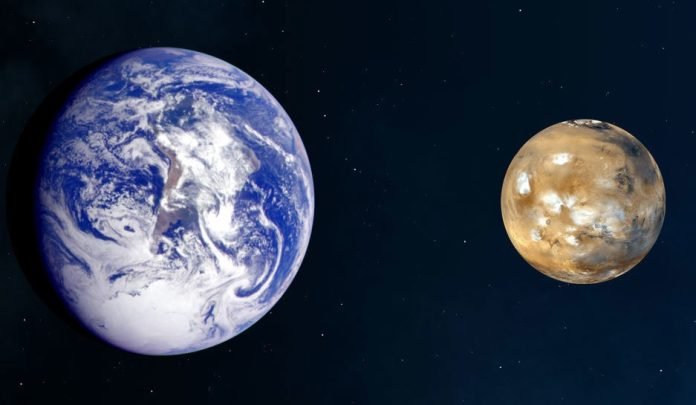
We are all too familiar of the Moon’s effect on our planet. It’s relentless tug causes our tides but even Mars, which is always at least 55 million kilometres away, can have a subtle effect too.
A study has revealed a 2.4 million year cycle in the geological records that show the gentle warming and cooling of our oceans.
The records match the interactions between the orbits of Earth and Mars over the longest timescales.
These are known as the ‘astronomical grand cycles’ but to date, not much evidence has been found.
The rhythmical rising and falling of the oceans has been well documented. Even the Sun at an average distance of 150 million kilometres exerts enough of a pull to enhance the effect from the Moon, giving us the spring and neap tides.
The Moon’s influence is easy to understand due to its proximity, the Sun’s too due to its enormous mass but Mars is a different story.
After all, it’s about half the size of Earth and even at its closest is about 55 million kilometres away.
As Earth and Mars orbit around the Sun, their interactions, or rather the gravitational pull from each upon each other are cyclical.
These are the astronomical grand cycles and for Earth and Mars they cycle every 2.4 million years.
A paper recently published in Nature Communications reports upon the work of scientists from the University of Sydney and Sorbonne University in France.
The team used geological records from the deep sea and to their surprise found a connection between the astronomical grand cycles, global warming patterns and deep ocean circulation.
They found a 2.4 million year waxing and waning of deep ocean currents and that seemed to link to increased climate.
A definite link emerged but it should be noted that ocean currents are not the only cause of global temperature changes.
The current temperature increases have a much stronger link to the human emission of greenhouse gasses.
The paper was authored by Dr Adriana Dutkiewicz and Professor Dietmar Muller from the University of Sydney and Associate Professor Slah Boulila from the Sorbonne University.
They reached their conclusion following analysis of the deep-sea sediment records acquired from over half a century of drilling data from hundreds of sites worldwide.
The 2.4 million year cycle they found can only have been caused by the interactions between Earth and Mars.
The interaction of the gravitational field of the two planets means periods of higher incoming solar radiation every 2.4 million years and with it, an increase in global temperatures.
Their analysis of the sediments showed breaks in the sedimentary deposits which related to periods of warmer temperatures and more vigorous deep ocean circulation.
The result helps us to understand how deep ocean eddies are key to warming ocean temperatures. Understanding these can help us to understand and model future periods of warming.
It may even go some way to mitigate a temporary cessation in ocean currents due to a change in the Atlantic meridional overturning circulation.
This drives the Gulf Stream that helps to keep Europe and other temperature countries the nice warm climate it has become accustomed to.
Written by Mark Thompson/Universe Today.



